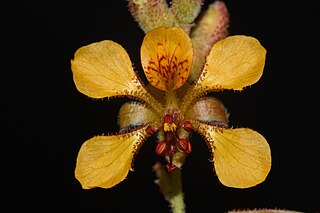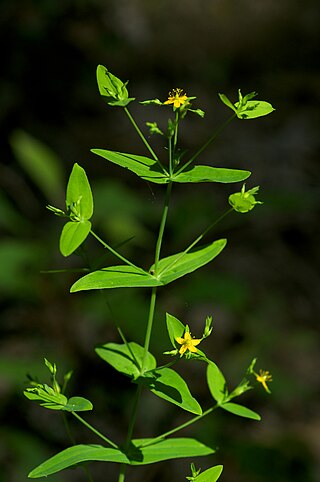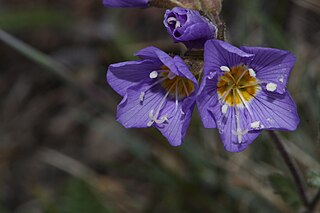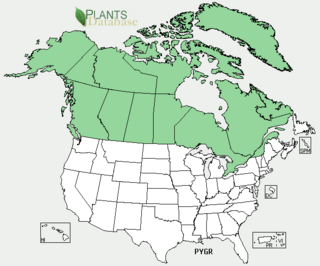
Polemonium reptans is a perennial herbaceous plant native to eastern North America. Common names include spreading Jacob's ladder, creeping Jacob's ladder, false Jacob's ladder, abscess root, American Greek valerian, blue bells, stairway to heaven, and sweatroot.

Polemonium, commonly called Jacob's ladders or Jacob's-ladders, is a genus of between 25 and 40 species of flowering plants in the family Polemoniaceae, native to cool temperate to arctic regions of the Northern Hemisphere. One species, Polemonium micranthum, also occurs in the southern Andes in South America. Many of the species grow at high altitudes, in mountainous areas. Most of the uncertainty in the number of species relates to those in Eurasia, many of which have been synonymized with Polemonium caeruleum.

Polemonium viscosum, known as sky pilot, skunkweed, sticky Jacobs-ladder, and sticky polemonium, is a flowering plant in the genus Polemonium native to western North America from southern British Columbia east to Montana and south to Arizona and New Mexico, where it grows at high altitudes on dry, rocky sites.

Rudbeckia laciniata, the cutleaf coneflower, is a species of flowering plant in the family Asteraceae. It is native to North America, where it is widespread in both Canada and the United States. Its natural habitat is wet sites in flood plains, along stream banks, and in moist forests. Common names other than cutleaf coneflower include cutleaf, goldenglow, green-headed coneflower, tall coneflower, sochan and thimbleweed.

Hoffmannseggia glauca is a dicot found in the legume family, Fabaceae. Its common names include Indian rushpea, hog potato, and pig nut.

Polemonium carneum is a plant native to the northwestern United States west of the crest of the Cascade Range, from Washington south through Oregon to the San Francisco Bay Area in California.

Polemonium eximium, the skypilot or showy sky pilot, is a perennial plant in the phlox family (Polemoniaceae) that grows at high altitudes. It is endemic to the Sierra Nevada in California where it grows in the talus of the high mountain slopes.

Hypericum mutilum is a species of St. John's wort known by the common name dwarf St. John's wort. It is native to parts of North America and is present in other parts as an introduced species. It is an annual or perennial herb taking a multibranched erect form up to about 60 centimeters tall. The oval green leaves are one or two centimeters long and are covered in tiny glands. The inflorescence is a compound cyme of tiny flowers. H. mutilum subsp. mutilum and subsp. boreale have a diploid number of 16, and H. mutilum subsp. boreale can have a diploid number of 18.

Polemonium californicum is a species of flowering plant in the phlox family known by the common names moving polemonium, low Jacob's-ladder, and California Jacob's ladder. It is native to the northwestern United States, where it grows in shady and moist habitat, such as mountain woodlands. It is a hairy, glandular rhizomatous perennial herb forming clumps of several decumbent to erect stems 30 to 50 centimeters in maximum height. The leaves are up to 20 centimeters long and are compound, made up of several pairs of oval to lance-shaped leaflets. The leaflet at the tip of the leaf is often fused to the pair behind it. The inflorescence is a crowded cluster of bell-shaped flowers each up to 1.5 centimeters wide. The flower is blue or purple with a yellow center and a whitish tubular throat. The fruit is a capsule.

Polemonium chartaceum is a rare species of flowering plant in the phlox family known by the common names Mason's Jacob's-ladder and Mason's sky pilot. It is native to California, where it has a disjunct distribution. It occurs in the Klamath Mountains as well as the ranges east of the Sierra Nevada, including the White Mountains, where its distribution extends just into Nevada. It is a plant of high elevations, growing in exposed, rocky mountain slope habitat such as talus and alpine fellfields.

Polemonium micranthum is a species of flowering plant in the phlox family known by the common names annual polemonium or annual Jacob's-ladder. It is native to western North America from British Columbia to North Dakota to California as well as disjunct in the Andes of southern Argentina and Chile. It can be found in many types of shrubby habitat, such as sagebrush scrub and foothill woodlands. It is an annual herb with a branching or unbranched stem taking a matted, spreading, or upright form. The slender stems are up to about 30 centimeters long and the herbage is coated in short, soft hairs and stalked glands. The leaves are located along the stem, each divided into several small leaflets. The solitary flowers have small white or pale blue lobed corollas tucked within cuplike calyces of hairy, pointed sepals.

Polemonium occidentale is a species of flowering plant in the phlox family known by the common names western polemonium and western Jacob's-ladder. There are two subspecies. The common ssp. occidentale is native to western North America from British Columbia to Colorado to California, where it can be found in moist areas of many habitat types, including meadows and woodlands. There is also a rare subspecies, ssp. lacustre, which is known only from a total of three counties in Minnesota and Wisconsin, and is found only in white cedar swamp habitat there.

Polemonium pulcherrimum is a species of flowering plant in the phlox family known by several common names, including beautiful Jacob's-ladder, showy Jacob's-ladder, and skunk-leaved polemonium. It is native to western North America from Alaska and Yukon to Arizona and New Mexico, where it can be found in many types of mountain habitat, including alpine talus and rock cracks at high elevations. It is a common and widespread wildflower in several regions. It is a perennial herb producing a clump of several erect stem approaching a maximum height of 30 centimeters. The leaves are mostly basal, with smaller ones arranged along the stem. The leaves are made up of several pairs of lance-shaped to oval or round leaflets. The herbage is lightly hairy, densely glandular, sticky, and strongly scented, the odor reminiscent of skunk. The showy inflorescence is a dense elongated or headlike cluster of bell-shaped flowers each just under a centimeter wide. The flower is deep to bright or pale blue to nearly white with a yellow throat.

Cardiospermum halicacabum, known as the lesser balloon vine, balloon plant or love in a puff, is a climbing plant widely distributed across tropical and subtropical areas of Africa, Australia, and North America that is often found as a weed along roads and rivers.

Thalictrum alpinum is a species of flowering plant in the buttercup family known by the common names alpine meadow-rue and arctic meadow-rue. It is native to Arctic and alpine regions of North America and Eurasia, including Alaska, northern Canada, and Greenland, and it occurs in cold, wet, boggy habitats in high mountains farther south.

Senna italica, the Port Royal senna, Italian senna, or Senegal senna is a legume tree in the genus Senna. It is recognized by many other common names based on the regions it grows in. In India, it is used to produce a powder for treating hair-related diseases which is known as “neutral henna”. Whereas, in some parts of the world, this species is cultivated for the leaves which yield the drug senna, known commonly as Senna glycoside, which in turn is the base for a laxative. Senegal senna is easily distinguishable through its many distinctive features. There are 3 subspecies of this plant based on the size of the inflorescence and the length of the petiole. The subspecies are italica, micrantha, and arachoides. In many regions, this plant is cultivated commercially and medicinally.
Polemonium pectinatum is a species of flowering plant in the phlox family known by the common names Washington Jacob's-ladder and Washington polemonium. It is endemic to the state of Washington in the United States, where it occurs in the Columbia Basin, including the Channeled Scablands and the Palouse.

Polemonium vanbruntiae is a species of flowering plant in the phlox family Polemoniaceae. It is known by the common names Appalachian Jacob's ladder, bog Jacob's-ladder, and Vanbrunt's polemonium. It is native to eastern Canada and the northeastern United States.

Pyrola grandiflora (, commonly known as Arctic wintergreen or largeflowered wintergreen, is a hardy perennial evergreen subshrub in the family Ericaceae. It is widely distributed in the Northern Hemisphere from temperate to tundra-like climates.

Hedysarum boreale is a species of flowering plant in the Fabaceae, or legume family, and is known by the common names Utah sweetvetch, boreal sweet-vetch, northern sweetvetch, and plains sweet-broom. It is native to North America, where it is widespread in northern and western regions of Canada and the United States. The ssp. mackenzii can even be found in the Canadian Arctic Archipelago.





















